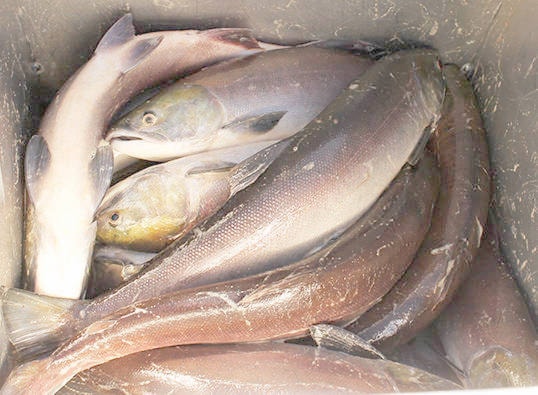The sockeye harvest by Lake Babine Nation (LBN) members was dramatically lower this year than in previous years when stocks were healthier.
Around 8,300 sockeye were taken by LBN members from the Babine River fish fence during the three-week period it was open until Sept. 2, as Donna MacIntyre, Fisheries Director with LBN told Lakes District News.
In normal years when salmon numbers are higher throughout the Skeena River Watershed, LBN anglers could harvest 39,000 sockeye from Aug. 1 to Labour Day.
More than 75 per cent of LBN’s food fish harvest comes from the Babine counting fence.
“We closed the fence [after Sept. 2] to allow the fish to go spawn. It was the first time. I always say ‘the grocery store is always open’ but this year it wasn’t,” MacIntyre said.
But the low numbers of sockeye spurred LBN to limit the season to just three weeks. It also chose not to open its commercial fishery.
Other neighbouring First Nations such as the Gitxsan and Wet’suwet’en sought bans in late July on fishing in their traditional territories.
READ MORE: No plans to ban sockeye harvesting, LBN says
READ MORE: Gitxsan salmon crisis team appeals for collaboration
READ MORE: Wet’suwet’en Hereditary Chiefs ask the Wet’suwet’en to stop harvesting sockeye
“We decided that conservation was important. We had to balance conservation with food fish and Aboriginal rights and title,” MacIntyre said.
Under Department of Fisheries and Oceans (DFO) regulations, when sockeye numbers fall to 400,000 it is considered a conservation crisis and no food fishing is permitted.
On Aug. 9 the count estimate was at 600,816, she said.
Recreational sockeye fishing in Babine Lake and its tributaries - including the Babine River - has been closed since July 11, since stocks didn’t reach the 800,000 threshold of the DFO’s integrated fisheries management plans.
LOOK BACK: Skeena mainstem closed to recreational sockeye
Coho fishing on the Babine River remains open, and anglers are allowed to take two of the species per day, and one of them can be over 50 centimetres, as DFO spokesperson Louise Girouard said.
Many LBN members found the reduced food fishery difficult to handle, as MacIntyre explained.
“I got lots of calls from people saying they didn’t have enough. I had people phoning me and crying. Just yesterday I was dealing with an elder who said ‘I don’t have enough to feed my grandchildren. The fish you give me isn’t enough for the winter.’”
“[And] it’s a long way to drive to the fence. If you have a small limit it’s really not worth it.”
Some members can still fish using nets, but MacIntyre said the quality of most salmon is decreasing now that the season is almost over and sockeye flesh is becoming less palatable.
“For LBN, as stewards of [most of] the Skeena sockeye stocks, it can be difficult for us to balance food fish and conserving for future generations. It’s a fine line and the people who depend on fish for their protein can suffer. Diabetes is running rampant in our communities and that sockeye is important and it saves them money. But if they don’t have enough fish they end up having to buy cheap food. With salmon being a backbone of our culture it’s also a health issue because they need that protein,” MacIntyre said.
